![]()
![]()
![]()
Use LEFT and RIGHT arrow keys to navigate between flashcards;
Use UP and DOWN arrow keys to flip the card;
H to show hint;
A reads text to speech;
33 Cards in this Set
- Front
- Back
|
Southeast asia history |
-Hindus and Buddhists - there are many things that stem from this civlization and way of life - India and modern pakistan as well - in ancient southeast asia there are also religions that stemmed from here and religious beliefs that developed locally - this spread throughout asia through syncretism and the silk road - hinduism and buddhism there is a varity of styles and different tastes - the influence and culture is also very different - these different gods sometimes look wealthy and somtimes appear to be very humble looking - the patrons were religious and political leaders - artist created this art as an act of devotion and it was often times part of their dharma - there was highly organized training grounds and workshops - the artists were often trained and there are regional distinctions - all thigns become the axis mundi (archiectrue and image) - this axis mundi gives the diety a vessel on which they can come down to earth |
|
|
Hinduism |
- early dravidian - this was created in 1500 BCE in the Indus River Valley - the dravidians worshipped nature gods and goddess because they are super peaceful, a wars god, fertility goddess, nomadic warriors, syncretism, symmtery - there is the caste system - there was aryan conquest- the persion cousins from teh north that take over the peaceful, nomadic warrior - there is eventually this concept of the divine |
|
|
Brahma |
- this is the great one or the supreme self - we get this diety in hinduism - he is with many different things and in many different manifestations - all things are intraconnected - all the same -this is hard to realize on earth - ultimately we go up wthen we will rejoin Brahma - this exsists and we are al infinite also this is a polytheistic religion - mosksha is the journey or end result of finding Brahma - there is an eterenal wheel that is indefinite - he is omniscent and omnipresent - everything emerges from Brahama most difficult to relate to like the holy spirit in some way - know he is there but unsreu what he looks ike and hes seated on the lotus which can touch and grab us all - universal principle, ultimate reality, cosmic knowledge, truth, source of everything - distinct Brahma (god) - Brahmin (Caste) - hes an intecessor of some sort |
|
|
Dharma (caste system) |
- this has to do with both karma and moksha - christians view the world as linear but the hindus dont - merging and the conquest cant fully seperate it - good and bad karma see where you will go in to in and what next darma you will be apart of - you are supoosed to do your dharma and this makes a stagnant society because cant be creatievena dfree - this is a great form of social control only way to be perfect is being one way that you are assigned to - there is a sense of entitlement due to the caste and dharma system - moksha is the release from teh world - non material and unseen world is the real and permenant world - the material world should be transcended; but they are allowed to enjoy it while a part ofit - there is a cosmic struggle - blance of the foces there is not a full destruction of forces - this always is a battle btween the good and the evil but this is a good balance because wihtout sadness what would one know of happiness you must experinece the opposite - |
|
|
Hindu ritual |
- there is prayers and offerings to summon the presence of god -gods can inhabit statues - creating art is an act of devotion ( being an atist was part of the caste system so this is heritary of some sort - the Brahmain caste were usually the patrons - the vaishyas as were the skilled laborers were the the good karma artists and those that will go on and follow their dharma |
|
|
Mount Meru |
this is the home of the gods - this links to axsis mundi which links the earth and the heavens together - there is a connection to architecture - there is a spiritual world where one can acess the divine and where gods can come to the earth - this axis mundi shows up in alot of the art |
|
|
Vishnu, Brahama, Shiva |
- they are responsible for the cosmic time |
|
|
Shiva |
- destroyer and a creative force - this means that he is associated with duality - he is both benevolent and nurturing - this is fearsome and destructive - but this is not a negative destruction - both masculine and feminine - shiva is more a male and nurtures and destroys - this brings renewal the destruction - they need both masculine and feminine energy - there is an incomplete person without both sides |
|
|
vishnu |
- perserver/ and maintainer - like jesus and how he saves people at different times - relaxing on a bed of serpents in the art - and the image of vishu in dreaming of the universe |
|
|
mandalas |
- they are made for the process - with the grains of sand and they are made in a way where they are made out of meticulous detail - the hindu plans are often based on the mandala - this shows a microcosm of the world, is done as meditative tool, and also as a spiritual plan - this is a way to relax the mind and meditate - meditate on some aspects - a map of the universe of the mundane and the spiritual, center, and sometimes axis mundi( this anchors everything in a proper place) |
|
|
hindu architecture |
- temple plan is based on the mandalas - exterior is mostly decorated portion - the interior is really dark, about the axis mundi, and architectural elevation based on Mount Meru - supposed to feel like going in and through a cave |
|
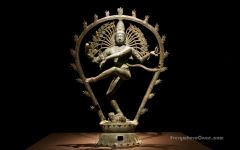
|
Title- Shiva as Lord of the palace (Nataraja= king lord statue) Location- India, Hindu during the Chola Dynasty Date- 11th C Material- cast bronze and this is a 29" processional Context/Meaning- he is in motion - Shijpa Shastras ( the sciene and the rules of art) its a book an canon - this is a canon of hindu iconography - human or the divine body represents some sort of element of nature - makes the divine body perfect in some way and exquisite - the face= the moon - the limbs= the bamboo and lonevity - eyes= almonds - the third eyes shows the he is all knowning and creator of destruction and creator - the rythm= he has his own drum - there is a circle of arms which show the ciclacal nature of the universe and he is dancing a dance - he is just captured in the moment of dance - seems to be moving in different ways - this is all about death and rebirth - his hands are important and his left hand is down showing that this is some kind of release - mudras is symbolic sign language that expresses what they are doing - lead a life of rightousness you will be blessed with a sort of release - there is a destructive element - the third eye can see beyond the mundane world into the spiritual - hari is supernatural and is dreadlock mess of some sort - this hair also has cobra heads which is a symbol of death and rebirth - jewlery shows that there is super high up and above but in some way the jewlery is meaningless and a material illusion - there is also a demon aposmala= and baby which is all about illusion and ignorance - under his foot this demon is immortal and being respressed without being destroyed - cant have good without eveil - the illusions that ten you from understanding the divinity within you - there is a rhtyn and everything is cycling in nature - he is in peace smile because has complete control in some way |
|
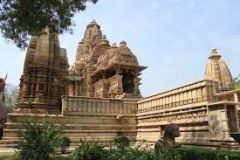
|
Title- Iakshama Temple From Lnajurano temple complex Location- Hindu, India Chadella Dynasty Date- 930-950 Context/Meaning- every space is decorated don't want to leave any space exposed - dont want to let the evil in any way= hori vacui hindu archiecture - elevated on high pedestals or staircases - they deliberately rejected the arch - the outside there is a lot of design and on the inside there is a dark space - dark cave like quality which is elevated on high pedestals - there are corbelled roofs and ashlar masonry - this is reference to Mount Meru - there is sculpture that crowds every surface - worlds on sheet - the porch and the detail is sickly amazing - axis of the divine union that is experienced - there is also union between the sexual union that is achieved - can access the supernatural through mundane ways bliss of the divine and masculine and feminine energy - trantic ritual which is practiced by some huinduse no shame about the body - they love the human form and the depictin of it 0 there is a softness to the human formal - they are all immortian in some of the figures - the passion and imtimate experience - very rounded and much more sensual and curvier - and there are softer eleements they are the most decorated - shared experience witht eh pleasures of the world inseide the temple this is all the falls away will enter a spirtiaul place - bliss of the divine through sexual union - tianic ritual -naturalness the fleshiness of the figures as well is apparent - exterior the person or onlooker is bomabred with images that are sensual - then the inner sanctuary is darker and a womb like chamber - this is the home of the diety - there is scupltures of god all around - limited access just to the priests and elite because this is not fr congressional worship but rather very intimate - the dark nature is intentional because you are supposed to focus on own experience when you are in there - the womb chamber is a cave with corbelling, quiet, primordial - the reliefs relate to the four armed vishnu in the way that they are less extravagant - byzantine church is similar with the exterior and interior - tak mahal and islam is the opposite - mara muslims conquer the northern india and have influence |
|

|
there is also union between the sexual union that is achieved- can access the supernatural through mundane ways bliss of the divine and masculine and feminine energy- trantic ritual which is practiced by some huinduse no shame about the body - they love the human form and the depictin of it0 there is a softness to the human formal - they are all immortian in some of the figures- the passion and imtimate experience- very rounded and much more sensual and curvier- and there are softer eleements they are the most decorated- shared experience witht eh pleasures of the world inseide the temple this is all the falls away will enter a spirtiaul place |
|
|
Buddhism History of creator |
- also known as the enlightened one - buddha is a title and his real name is siddhartha but he is a prince -his father is a wealthy warlord - Siddhartha Guatama 6th C BCE India - he is locked in his paace and surronded by all people with beauty, luxury but he still has a spiritaul crisis and he wanted to see the world beyong the plae but the paretns didnt want him to see this - they wanted what was best for him at all time - he doesn't feel content and is psirtiaully restless - there are some many different branches of Buddhism thats developed due to syncretism - its easy for it to develop because of the spiritual invoking practices also the aesthetic or divine entitites seem magical - he goes out in a carriage and has a journey and realization - he sees and old man, a sick man, and a dead man - everythign begins to make sense because he lived a privilidged life - he now knows of death and decay and suffering and knows that death is bound to happen - looks to hinduism for answers but he finds it unsatisfying spiritually - he begins to reject all things of the spiritual world - simple robes, one grain of rice, sleeps on a bed of spikes and still gets depressed when he rejects all luxury - he goes to sit under a bodhi tree - he feels foggy and unstatisfied both ways and begins to meditate - he has a relevation when he does so |
|
|
The four noble truths |
1. life is suffering 2. suffering is caused by desire 3.eliminate attachment - the eightfold path- this is the middle way and full of compassion - can set the body free without desire and suffering this allows people to remove themselves - there is more supernatural - buddhas turn into relics -they need to get to a point intellectually as well its about the self and the individual - this is all about living a balanced life - The eightfold path is all about living a balanced life |
|
|
The eightfold path |
- The eightfold path is all about living a balanced life - past life was too luxurious and nothing was painful - realized that a life of balance leads to happiness - all experience suffering from time to time dont add to a persons suffering treat them with kindness- free from own suffering and other will acheive nirvana - go throught hte damn wheel is exhausting at a certain point - all about experience and temptation and sufferings - accept there are illusions of the material world and you are above them - dont be attached to anything - art commemorates him not as a god but ot remind of the teachings and his experience |
|
|
Buddhist iconography |
- early on they want to show him buddha by not showing him - not the iconic image follow in the footsteps but dont worship him was the goal of this message - footprint and empty throne: his presence - empty chair dont worship him but rather the idea of him and his teachings - the bodhi tree, meditation, experience the ways - the lotus as well the pure nature of buddha - later he is seen as a king and lion- they show he is from a noble family - king associate him with buddha - elephant his special birth and strength as well |
|
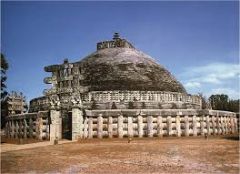
|
Title- The Great Stuppa at Sanchi Location- Pradesh India, Madhya Empire- Maugra Late Sung Dynasty Date- 100-300 CE Material- Stone masonry, dressed sandstone on dome Context/Meaning- there are many patrons -stupa= mound and this structure is totally solid dirt - around there is dressed stone - only the relics go around it - its a representation of the microsm of the world, body, shape of buddha, axis mundi, reliquary - this represents the body of Buddha sepulcher (reserved for pre buddhist teachers) - the stuppa exists for an art form witha new meanings - umbrella are associated with the royal chats - the backbone is the landscape - this shows sacredness of how buddhas body are here - mount meru is important and a mound relates to hinduism (the dome of the universe) - and the madara plan - there is no way to go inside because it is a mound of earth - originally painted - enter through the gate wasy and are suposed to come in an angle like way - there is a buddhist swastika which is a symbol of good luck and good fortune continity of good luck - enter through 1 of 4 doors which represent the 4 corners of the earth - circumabulate or walk in a clockwise motion in the firection of the sun to represent buddhas journey - meditate on the samsara and buddhas journey - the journey into the sacred space represents buddhas departure from the world and created harmony in ourself and with the universe changes the way you think - the railing (buturade) to mark a scared space - space mandala and yasi and ubrealla chatra serve as azis munis - the dome is the cosmos and mount meru is meditating on buddha - around the wheel pivots and relics are burried in the center - there is physical meditation to transcend to the spiritual world - this is a physical replication of the spiritual journey - what makes this scared is who can enter this space - east= buddhas birth south= enlightenment west= first sermon north=nirvana - zenith and nadis - unvoming hbu of the great wheel (samara) - the entrance ways all have an importance - there are many stairways - meditate amoung own path and the stories of buddhas life and past lives (Jatka tales) - aniconic representations of Buddha and later there are a few images of buddha - hindu presence - this is marked as sacred and not just due to certain elements - there is aniconic representation of buddha so without the figure or body of budhha= wheel, footprints, bodhi tree, the lotus, lions, horse has no riders - everyone is processing and celebrating him - elephants enter on one side - peackcok but as regards to buddhas royalty - north gate= the women under a mago tree - pre buddhist the fertitlity goddess hangs from a mango tree - there is a breast and pubic triangle Yakshi this the fertitlity figure that is hindu - mixture in the gate- - syncrtized gods and goddesses - buddhism is changed all over and exported - the silk road helps with this process and indonesia - JAVA |
|
|
Yatsi |
spinal colum and backbonee |
|
|
anda |
the dome |
|
|
harmaka |
a box |
|
|
Aniconic repsentations of buddha |
- later there are few images of buddha - there are natural and fertility symbols of buddha -without the figure or body of budhha= wheel, footprints, bodhi tree, the lotus, lions, horse has no riders |
|
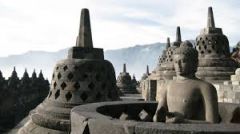
|
Title- Borobudor Temple Location- java Indonesia Date750-842 15th c material- volcanic stone masonry context/meaning- islam takes over and and sight is completetly abadnoned - originally hindus- then buddhist- then neglected for a few years until the british rediscovery - this is a pilgramidge site for the buddhists - 20th c there is better restoration they took down the jungle - burried a god and made a structure - immortalized in profile by a near by mountain range - god structured it - mandala plan and elevated on a hill - divine architect is visible in nearby mound - remodeleed serval times - all open air and terraced passageway radiate around axis mundi - circumambulate upwards - central stuppa englightened mind - is like the spiritual path - the highest points are reserved for the elite and the bodhistavas - 70 years and 2000 plus reliefs, 72 stuppas, 500 plus images of buddha - pilgramidge site for the early commemoration of Buddhas birth, enlightenment and nirvana - meditate on visuals - Buddha is divine and some stuppas are completely open - there are reliefs of Buddha, Jataka tales, spiritual paths, - siddarthas mother was maya and royal and special - the umbrellas show the royalty of the place and nobility - there is some naturalism that is borrowed or given from Buddha - waking the path and taking a journey where you want to go this has a relation to spirituality |
|
|
Buddhist Iconography |
1. mudla= the open hand or hand gesture 2. lotus is meditative 3.turning wheel -the teaching wheel - meditate in the lotus position - eyes closed - long lobes which shows that the huge weight of the material wealth has his ears still stretched and he rejected that world - also that he sees and hears all - third eye is the bun or annex to his brain on the top of his head that is supposed to make you feel little or smaller and for others to know that he has extra spiritual knowledge - simplicity of clothing as well to show the humble times that he went through - teaching of his laws through meditation - hand open on his lap= benevolence and charity -out and up= calm, meditation, chill, peace, courage, meditation - sitting on a lotus= overcoming suffering and or achieving enlightenment - reclining= nirvana and extinction - walking or standing= giving blessings and appealing for peace -super skinny= suffering before the enlightenent period - long ears= all seeing and knowing and wealthy background - third eye= this is the bun also all seeing or enlightened wisdom -hand down= conquering temptation - two plams forward= calm down the things in this world are all illusions
|
|
|
Buddha 8-11th C India |
- meditating and listening budhha, hes concentrating - skinny and long or little - long hair and its all up in a knot - shows he has more spiritual knowledge - simple meditation sitting on serpants |
|
|
Buddha 11-12th C Cambodia |
- feet and hands suggest meditation - sitting on coliled up cobra - big ears rejects the material world - references to part of his past - marking or something specific - more stylized - still suggest extra wisdom - enthroned on serpants |
|
|
Buddha 16th C thailand |
- calm down -giving a blessings as buddha walks around - eyes are closed showing hes meditating - extra knowledge - skinny - trying to to find spiritual contentment when he ate nothing and realized that was not good either - teaching and content |
|
|
Buddha 7th C Korea |
- cyclical nature of the universe - stands on a lion -charity and benevolence - calm and peace - extra knowledge - super pointy - and fancy - reclining to show peace and our extinct self that is allowed to achieve nirvana |
|
|
Buddha 11-12th Sir Lanka |
- 10 to 46 ft tall - reclining and achieving nirvana |
|
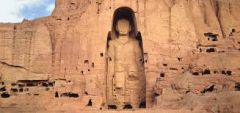
|
Title- Buddha from Bamiyan Date- 400-800 Location - afganistan Context/Meaning- they are threatened and want to destroy these idols - they are over 100ft tall - central asis and taliban thinks that they shouldnt be in an islamic country so they get rid of them Material- rock cut w plaster - cut rock but also plaster and straw and mud - there is a greco roman influence but specific detail and paint relates to the central asia - there are only the ones tht are hidden now because the others were blown up with anit missles |
|
|
3 golden eras of the silk road |
- this is when most of the exchange was going on - 2nd C BC- 2 C Ce during hellenistic alexander empire - 7th-10th C china islamic empire because much of the influence in china was already buddhist and spiritual and there were also islamic idea and technology -12-14th Mongol Empire can exchange teachings and texts where the huge buddhas were in the mountains and they found buddha pantings, scrolls and manuscripts, and places for m=worship to meditate and slepe along the road |
|
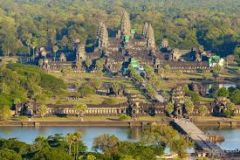
|
title- Temple Angor Wat and the City of Angor Wat Location- Thom Cambodia Date- Hindu and the Angor Wat dynasty 800-1400 Material- Sotne masonry, sandstone Context/Meaning- orginally a temple complex and the city was hindu - this is when hinduism was popular in india and translated to all others - this space became buddhist - the Angor Thom city was one of the lagest and heavily populated becasue there are over 1 million people in the 12th c - built with mortatr and mortise and tenon joints - etnire comple was built on a swamp - was to function as monolithic stones - angor wat= city temple and was built in the early 12th c - largest religious temple in the entire wold - means temple and does not need a fancy name because it is just simply awesome - King of the Khmer= Soyarvanmani 14 war against his uncle - jumps on his uncles elephant and assiantes him and become the king - hindu and temple dedicated to vishnu - vibrant city - pilgramidge - and this is also a burial site - insecure about his power since he was 14 years old and he wants to legitamize his power through this structure - he compares himself to vishnu through violence the persevers and the entertainer and destroyer - mount meru and pilgramidge and burla site - plan modeled after cosmic diagram of the universe - the reason that this faces the west - this was switched to buddhism in the 14th- 15th C - an actual diagram to change to change all the structure and lok and the religious role - entire complex is surronded by moat - keeples stable because its a swamp - water relatively constant - so it doesnt crumble - hydraulic temple "floating" flood plain - makes easier to transport goodd and more isolated and holy - also protective - and separated - larger than the vacant city - without the moat the city could not stand - jungle landscape and celaring landscape is a big thing - Jayaurman VII as Buddha at Angor Thom - later the king adopts the buddha portrait as a face - royal power as a symbol for this king - filled with smiling faces content and protecting the city with enforcements |

